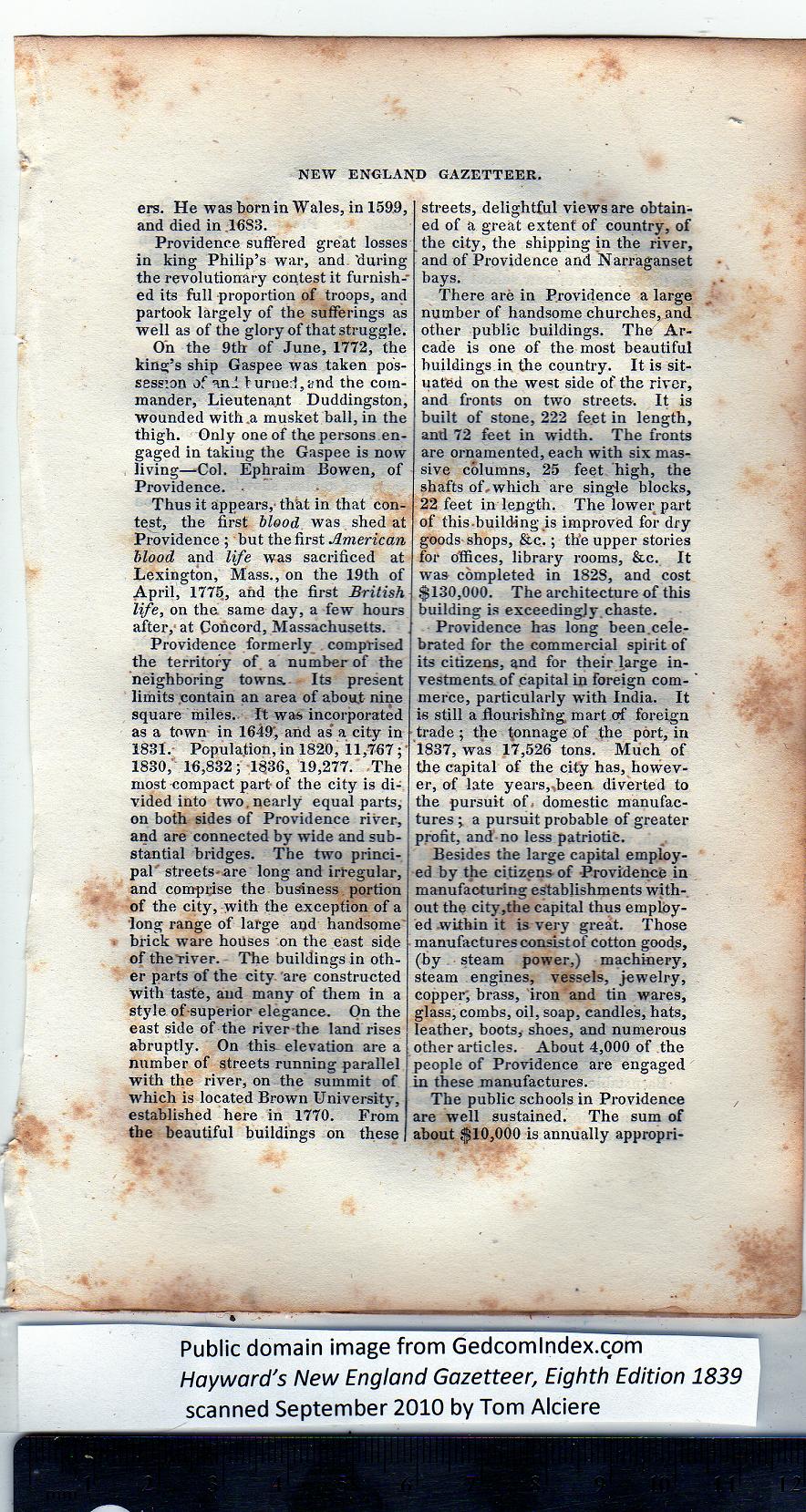|
ers. He was born in Wales, in 159.9,
and died in 16S3.
Providence suffered great losses
in king Philip’s war, and 'during
the revolutionary contest it furnish-'
ed its full proportion of troops, and
partook largely of the sufferings as
well as of the glory of that struggle.
Oh the 9th of June, 1772, the
king’s ship Gaspee was taken pos-
session of end turned,and the com-
mander, Lieutenant Duddingston,
wounded with .a musket ball, in the
thigh. Only one of the persons en-
gaged in takiug the Gaspee is now
living—^Col. Ephraim Bowen, of
Providence.
Thus it appears,- thht in that con-
test, the first blood was shed at
Providence ; but the first American
blood and life was sacrificed at
Lexington, Mass., on the 19th of
April, 1775, and the first British
life, on the same day, a few hours
after, at Concord, Massachusetts.
Providence formerly comprised
the territory of a number of the
neighboring towns. Its present
limits contain an area of about nine
square miles. It was incorporated
as a town in 1649', and as a city in
1831. Population, in 1820, 11,767; *
1880, 16,832; 1836, 19,277. The
most compact part- of the city is di-
vided into two. nearly equal parts,
on both sides of Providence river,
and are connected by wide and sub-
stantial bridges. The two princi-
pal' streets-are long and irregular,
and comprise the business portion
of the city, with the exception of a
long range of large and handsome'
brick ware houses on the east side •
of the river. The buildings in oth-
er parts of the city are constructed
with taste, and many of them in a
style of-superior elegance. On the
east side of the river the land rises
abruptly. On this elevation are a
number of streets running parallel
with the river, on the summit of
which is located Brown University,
established here in 1770. From
the beautiful buildings on these
streets, delightful views are obtain-
ed of a great extent of country, of
the city, the shipping in the river,
and of Providence and Narraganset
bays. |
There are in Providence a large
number of handsome churches, and
other public buildings. The Ar-
cade is one of the most beautiful
buildings in the country. It is sit-
uated on the west side of the river,
and fronts on two streets. It is
built of stone, 222 feet in length,
and 72 feet in width. The fronts
are ornamented, each with six mas-
sive columns, 25 feet high, the
shafts of, which are single blocks,
22 feet in length. The lower part
of this.buildring is improved for dry
goods-shops, &c.; the upper stories
for offices, library rooms, &c. It
was completed in 1828, and cost
$130,000. The architecture of this
building is exceedingly, chaste.
Providence has long been.cele-
brated for the commercial spirit of
its citizens, and for their large in-
vestments of capital in foreign com-
merce, particularly with India. It
is still a flourishing mart erf foreign
trade; the fonnage of the port, in
1837, was 17,526 tons. Much of
the capital of the city has, howev-
er, of late years,,been diverted to
the pursuit of, domestic manufac-
tures ; a pursuit probable of greater
profit, and no less patriotic.
Besides the large capital employ-
ed by the citizens of Providence in
manufacturing establishments with-
out the city,the capital thus employ-
ed within it is very great. Those
manufactures consistof cotton goods,
(by steam power,) machinery,
steam engines, vessels, jewelry,
copper, brass, iron and tin wares,
glass, combs, oil, soap, candles, hats,
leather, boots, shoes, and numerous
other articles. About 4,000 of the
people of Providence are engaged
in these manufactures.
The public schools in Providence
are well sustained. The sum of
about $10,000 is annually appropri- |
